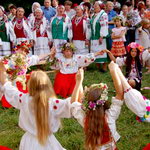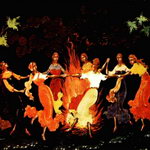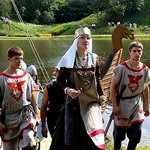Published: 2013-06-23
Reviews: 7327
Folk Festivals.
 Folk Festivals occupy a special place among Belarusian holidays calendar. And all because these days are especially appreciated by Belarusian people. Although the holiday calendar does not reserve days off for their celebration, they have been still awaited and much loved for several decades.
Folk Festivals occupy a special place among Belarusian holidays calendar. And all because these days are especially appreciated by Belarusian people. Although the holiday calendar does not reserve days off for their celebration, they have been still awaited and much loved for several decades.
January, 14 – Old New Year.
 One of the most paradoxical folk festivals is the Old New Year, which is celebrated from 13 to 14 January. It would be difficult for a foreigner to understand how the New Year can be both old and new, but for Belarusians this phenomenon is quite normal.
One of the most paradoxical folk festivals is the Old New Year, which is celebrated from 13 to 14 January. It would be difficult for a foreigner to understand how the New Year can be both old and new, but for Belarusians this phenomenon is quite normal.
The explanation for this paradox lies in the discrepancy between the Julian calendar ("old style" calendar) and the Gregorian calendar, for which the post-Soviet countries have moved immediately after 1917 revolution. However, the Orthodox Church has remained faithful to the traditions and continues to lead the chronology of all religious holidays according to the Julian calendar. In addition, people used to celebrate the New Year together with the Christmastide, which is just coincided with the celebration of the New Year in the old style.
All this confusion has gradually turned into an unusual tradition to celebrate first official New Year on the night of December 31 to January 1, and exactly 13 days later the Old New Year comes. However, despite the fact that the winter holiday came only through the calendar confusion, it became beloved, popular, and most importantly - family holiday, as it is one of the few days of the year when all family members can get together at one table.
January, 25 – the Students Day (Tatyana`s Day).
 In Belarusian calendar, there are several Students Days. The official state holiday is celebrated in November, but Tatiana's Day is much more popular among students.
In Belarusian calendar, there are several Students Days. The official state holiday is celebrated in November, but Tatiana's Day is much more popular among students.
The roots of the Students Day (Tatiana's Day) go to the XVIII century, when Empress Elizabeth signed a decree to establish Moscow University in 1755. Gradually, this day was celebrated by all students in Russia, and after the comprisal of Belarusian lands in the Russian Empire this tradition came to us. At that time it was considered to treat Saint Tatiana as the patron of students.
In Tsarist Russia this holiday was celebrated in the grand manner, with folk festivals, distribution of awards and encouragements, speeches were delivered. Since the XX century, the tradition has somewhat changed - although the official part and grandiosity have disappeared, students still celebrate their holiday with noise and fun.
There is a beautiful legend of the origin of Tatyana's Day holiday. It says that in the 3rd century AD, Tatiana, who was the abbess of a Christian temple, was repeatedly persecuted because of her commitment to the Christianity. One day, she was ordered to pray the pagan god, but in spite of everything Tatiana did not abandon their faith and prayed Christ even harder. Her prayers were so strong that a statue of the pagan god fell from its pedestal and crashed. After that Tatiana was executed. In 235, Tatiana's Day was firstly celebrated, and the martyr was canonized.
February, 14 – St. Valentine`s Day or All Amorous Day.
 St.Valentine's Day or All Amorous Day, is one of the most popular folk holidays. Different countries around the world have been celebrated this day for more than 16 centuries, but in Belarusian latitudes it settled down not so long ago - just over 20 years ago.
St.Valentine's Day or All Amorous Day, is one of the most popular folk holidays. Different countries around the world have been celebrated this day for more than 16 centuries, but in Belarusian latitudes it settled down not so long ago - just over 20 years ago.
The history of the holiday is associated with the name of St.Valentine, who lived in the middle of the III century BC and became famous as the patron of lovers. Despite the prohibitions to marry in the Roman legions in the period of Emperor Claudius II, Christian priest Valentine against all odds helped to connect the hearts of lovers with bonds of wedlock, passed notes of Legionnaires to their choices, reconciled quarreling people. Once this practice became known to the authorities, the monk was executed. The situation was very piquant, so Valentine himself fell in love with the jailer's daughter and wrote a letter signed "Your Valentine" to her before his execution, which took place on February, 14. There is also a legend associated with this winter holiday: it is believed, if married on Valentine's Day, the love will be eternal, and a family unit will be strong.
Valentine was later canonized, and in 496 Pope Gelasius announced February, 14 as St. Valentine's Day.
Since that time there has been a tradition in the world to celebrate February, 14 as All Amorous Day, the patron of which was St. Valentine. On this day lovers give each other gifts and exchanged love letters - "valentines." However, the tradition of sending cards to their loved came later - in the Middle Ages. The very first in the world valentine postcard was sent by Duke Charles of Orleans. It was a love letter to his wife, which the duke sent in 1415 during his imprisonment in the Tower of London.
In 1969, this date was removed from the official calendar of the Catholic holidays because information about St. Valentine was considered unreliable. Although the tradition to celebrate this day has only strengthened.
April, 1 – Laughter Day or All Fools' Day.
 On April, 1 in Belarus Laughter Day or All Fools' Day is celebrated. The history of the holiday is still ambiguous and uncertain. However, this does not prevent it from being one of the most anticipated and fun folk festivals.
On April, 1 in Belarus Laughter Day or All Fools' Day is celebrated. The history of the holiday is still ambiguous and uncertain. However, this does not prevent it from being one of the most anticipated and fun folk festivals.
There are several explanations about the origin of this day. The most popular version says that initially, in the ancient times, this day was celebrated as the Easter and the spring equinox with mandatory attributes – jokes, funny hanky-panky and antics.
According to another version, the cause of the spring festival was a shift to the Gregorian calendar in the XVI century. In medieval France, the New Year was celebrated at the end of March, and according to the new calendar, the celebration was postponed to January, 1. But despite the innovations, a certain category of citizens still continued to celebrate the New Year's week in the old style. They were laughed, joked and given wacky gifts, called April fools.
It is known that this holiday began to gain popularity in the XVIII century in Western Europe. Gradually, it began to spread in the colonies of England and France, and then came in our latitude. It is believed that in Russia, and then in Belarus the festival has appeared thanks to Peter I. By the way, he himself became a victim of an April Fool's joke. The fact is that on this day German actors had to appear in front of him, but instead of the promised pieces they put up a banner with a note "April, 1". Peter I did not get angry, just noted some liberties of the comedians to himself.
Holiday calendar says that on this day people make jokes and tease friends and relatives, give each other senseless orders and organize other jokes.
July, 7 – Ivan Kupala holiday.
 Ivan Kupala holiday is perhaps the most distinctive folk festival. The tradition of celebrating it in the middle of the summer draws its origins in the pagan past of the Belarusian people. During the worship of many gods and idols people began to celebrate the day of summer solstice. The name of the holiday in that period remained unknown, but with the spread of the Christianity in the East Slavic lands, the summer festival became associated with the day of the birth of John the Baptist, celebrated on July, 7 according to the Julian calendar. Since these times the people festival had ceased to correspond to the astronomical solstice and was named Ivan Kupala, which is a Slavic variant of the name John the Baptist (from the Greek word "bather”, “sinker”).
Ivan Kupala holiday is perhaps the most distinctive folk festival. The tradition of celebrating it in the middle of the summer draws its origins in the pagan past of the Belarusian people. During the worship of many gods and idols people began to celebrate the day of summer solstice. The name of the holiday in that period remained unknown, but with the spread of the Christianity in the East Slavic lands, the summer festival became associated with the day of the birth of John the Baptist, celebrated on July, 7 according to the Julian calendar. Since these times the people festival had ceased to correspond to the astronomical solstice and was named Ivan Kupala, which is a Slavic variant of the name John the Baptist (from the Greek word "bather”, “sinker”).
However, this cannot be called a religious holiday in the canonical sense, rather vice versa - it has still remained pagan, kept a lot of symbolic rituals, folk beliefs, and even a bit of devilry.
Ivan Kupala day and night is filled with a variety of rites related to water, fire, and herbs. The main and mandatory custom - mass bathing. It is believed that on this day all the evil spirits go out from the water, so you can swim safely and without risk to fall under their pernicious influence.
According to folk belief, on this day fire and water "are friends" with each other and get unusually strong natural cleansing power. That is why in Ivan Kupala people make big fires along rivers around which they first reel, dance and have fun, and then boys and girls jump through the flaming fire. It's some kind of purification, since it is believed that the fires scare evil spirits, which the Ivan Kupala night is filled.
Another tradition of the Ivan Kupala summer holiday is associated with herbs and flowers. Kupala herbs are considered especially healing and helpful. They are used in traditional medicine, burnt in furnaces during a storm, and also in binding ceremonies.
In Ivan Kupala girls lowered wreaths into the water woven on the eve with lit chips or candles. This custom of the folk holiday is nothing else than the fate fortunetelling: if the wreath floats, it promises a long life, well-being and a successful marriage; if the wreath goes under – it is a very bad sign.
However the star of Kupala is the famous "Fern-flower." It is known that the fern never blooms in nature. But people believe that fern still blooms on the night of Ivan Kupala for a few moments. Anyone who finds a flower, will be unusually rich. A person with this flower acquires extraordinary qualities, and you can easily see all the treasures buried in the ground.
Ivan Kupala Day is celebrated on the night of July, 6 to 7, and is the culmination of summer life in the Slavic peoples.
The second Saturday of July – Vitebsk City Day.
 Vitebsk is not just the cultural capital of Belarus, it is one of the oldest cities in the country, where the history of the Belarusian people could be seen best of all. The past, present and future is woven here together, probably that`s why you can feel the continuity of tradition and reverence for the past so much. Without the past – there is no future. Realizing this truth, the citizens celebrate the City Day with especial awe, trying to spend this Vitebsk holiday as possible colorful and brighter. On this day, the city as if changes: unheard-of various exhibitions come alive in the streets, promotions are held and the music sounds. Numerous fairs and workshops, which are a special addition to the summer holiday, excite the imagination, making again and again to admire the hidden talents of the human soul. The celebrations usually take place in all parts of the city with games, jokes and concerts in the open air. On its birthday the city as if turns into a single stage, where the main characters are played not by professional actors, but the citizens and guests of ancient Vitebsk.
Vitebsk is not just the cultural capital of Belarus, it is one of the oldest cities in the country, where the history of the Belarusian people could be seen best of all. The past, present and future is woven here together, probably that`s why you can feel the continuity of tradition and reverence for the past so much. Without the past – there is no future. Realizing this truth, the citizens celebrate the City Day with especial awe, trying to spend this Vitebsk holiday as possible colorful and brighter. On this day, the city as if changes: unheard-of various exhibitions come alive in the streets, promotions are held and the music sounds. Numerous fairs and workshops, which are a special addition to the summer holiday, excite the imagination, making again and again to admire the hidden talents of the human soul. The celebrations usually take place in all parts of the city with games, jokes and concerts in the open air. On its birthday the city as if turns into a single stage, where the main characters are played not by professional actors, but the citizens and guests of ancient Vitebsk.
This day becomes even more piquant, solemn and magic due to the fact that the celebration of Vitebsk coincides with bright and colourful days of "Slavonic Bazaar", so the centuries-long anniversary of the city is held particularly juicy, colorful and at full blast. The holiday fits well in the festival mess, so it has became larger and more colourful.
July – holding of "Slavonic Bazaar" festival in Vitebsk.
 For more than 20 years Vitebsk has been the centre of the largest East Slavonic music festival "Slavonic Bazaar".
For more than 20 years Vitebsk has been the centre of the largest East Slavonic music festival "Slavonic Bazaar".
"Slavonic Bazaar" festival was first held in summer 1992, and since that Vitebsk has become an annual weekly cultural capital of the Slavonic states. Best culture and art figures, thousands of entertainers, dance groups, theater troupes, artists, poets and just talented people come on these days in Vitebsk. Slavonic Bazaar has become the main unannounced summer holiday for residents and visitors of the city. During the festival days, everyone can find a place for entertainment, starting with seeing concerts to participating in master classes held by craftsmen.
And to learn the history, the traditions and trace the development of "Slavonic Bazaar" festival, simply visit Exhibition Hall "Dukhovskoy Kruglik", where the music festival will be talked about in more details by the unique exhibits in a separately decorated themed room.
November, 2 – Autumn Dziady in Belarus.
 Dziady - the day of the memory of the dead – is commemorated in the third week after the Intercession. This day, of course, has pagan roots in the calendar of holidays, but it has gradually become integrated into the obligatory liturgical calendar of the Orthodox people.
Dziady - the day of the memory of the dead – is commemorated in the third week after the Intercession. This day, of course, has pagan roots in the calendar of holidays, but it has gradually become integrated into the obligatory liturgical calendar of the Orthodox people.
Dziady is a home, family holiday. On this day people do not visit the dead relatives in the cemetery, on the contrary, they are invited to a memorable meal at home to entertain and thank for their patronage.
Housewives prepare for this folk holiday carefully: clean the house, prepare a variety of dishes. And before dinner, head of the family lights a candle and says a prayer inviting the departed ancestors at the table. According to the customs of this Belarusian holiday, the doors in the house should be open, not to obstruct the spirits of relatives. Dishing out, some of them should be laid on a special plate specifically designed for the dead relatives. And the number of dishes on the table should always be odd and not less than five, but each dish should be served in doubles (for example, 9 dishes were served on 18 plates).
At the memorial table people remembered the departed ancestors, their best qualities, tips, stories from their lives. And the history should always start about the oldest and most well-known ancestor. This tradition allowed gradually transfer the generation history from senior to junior.





